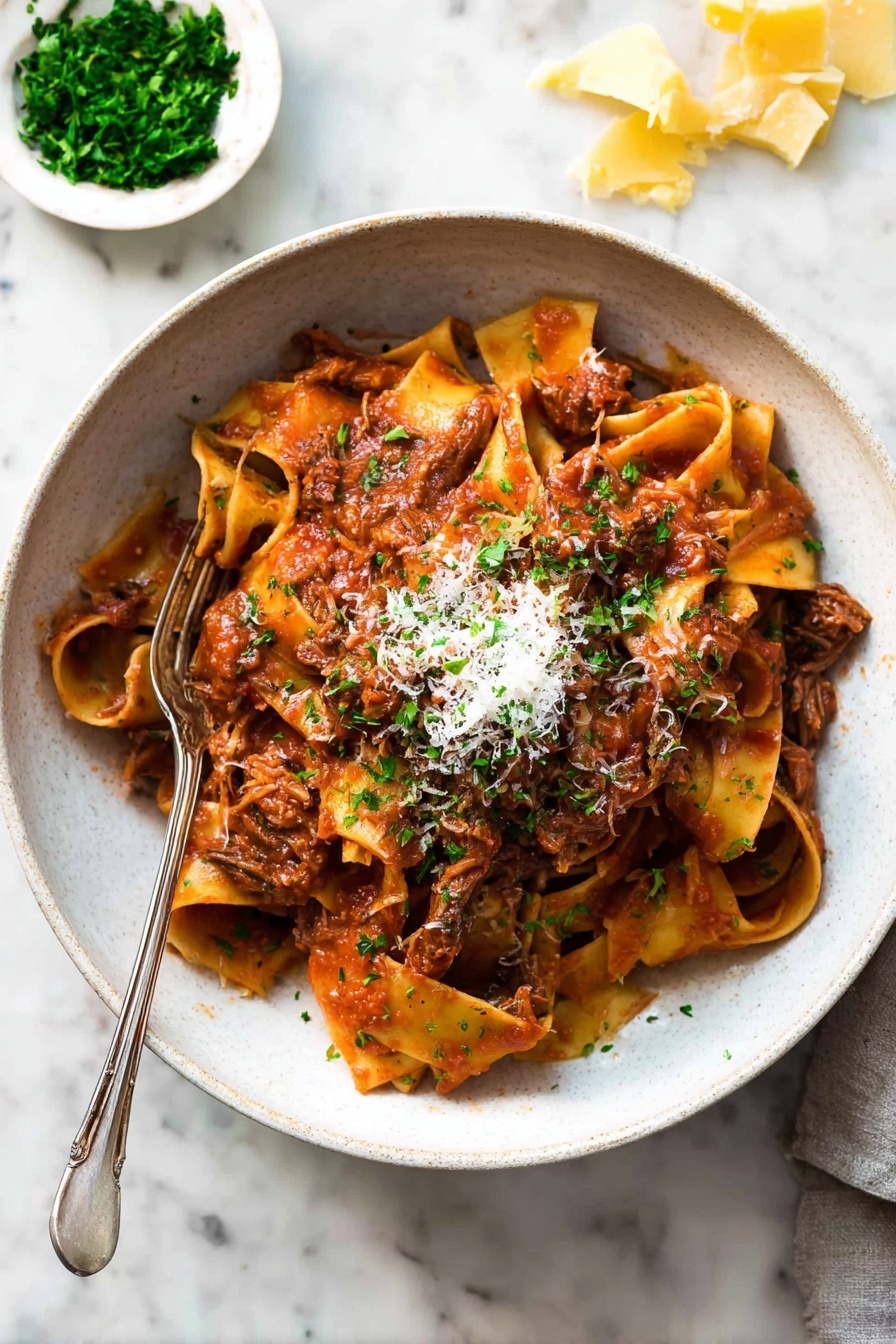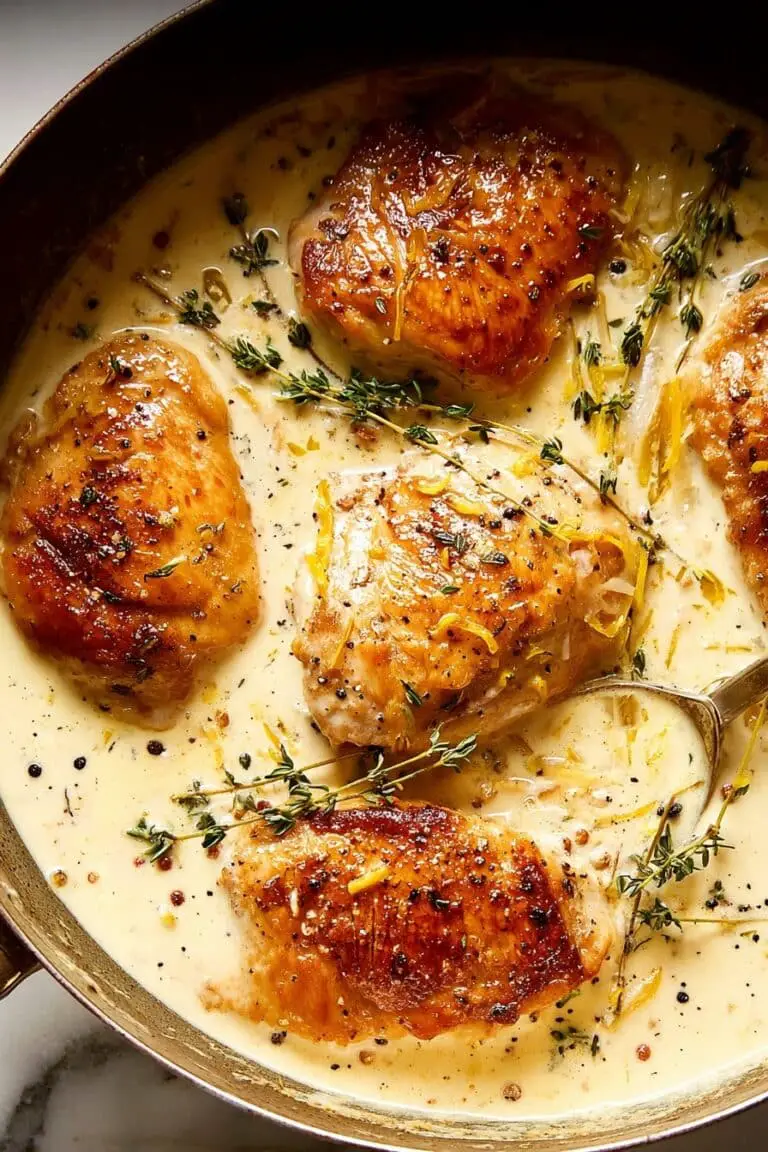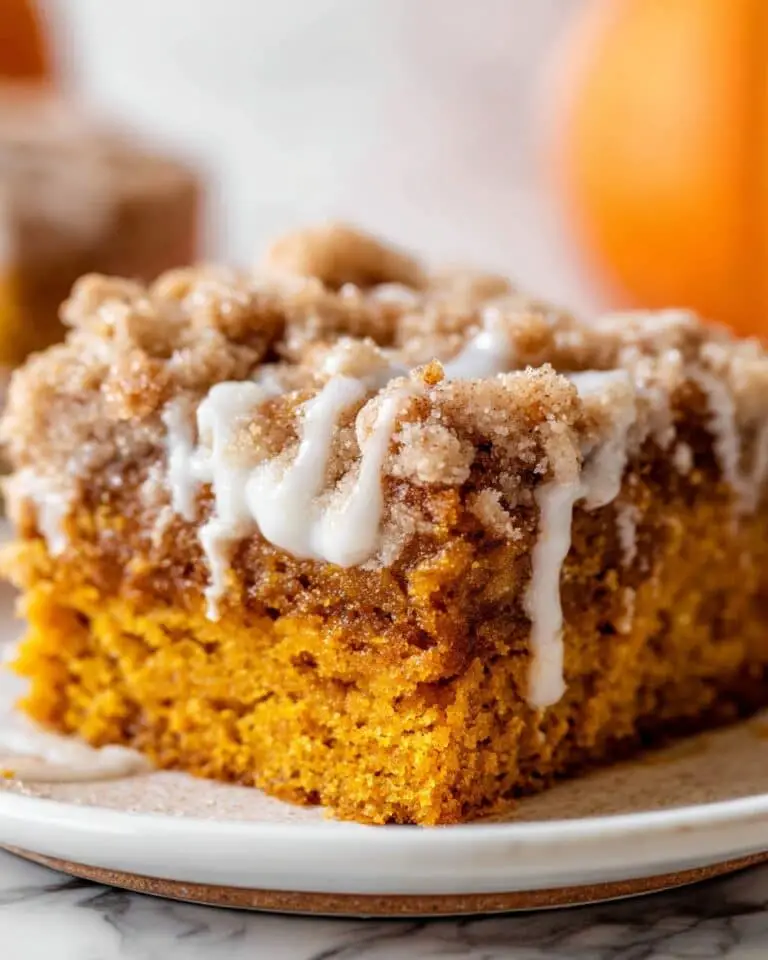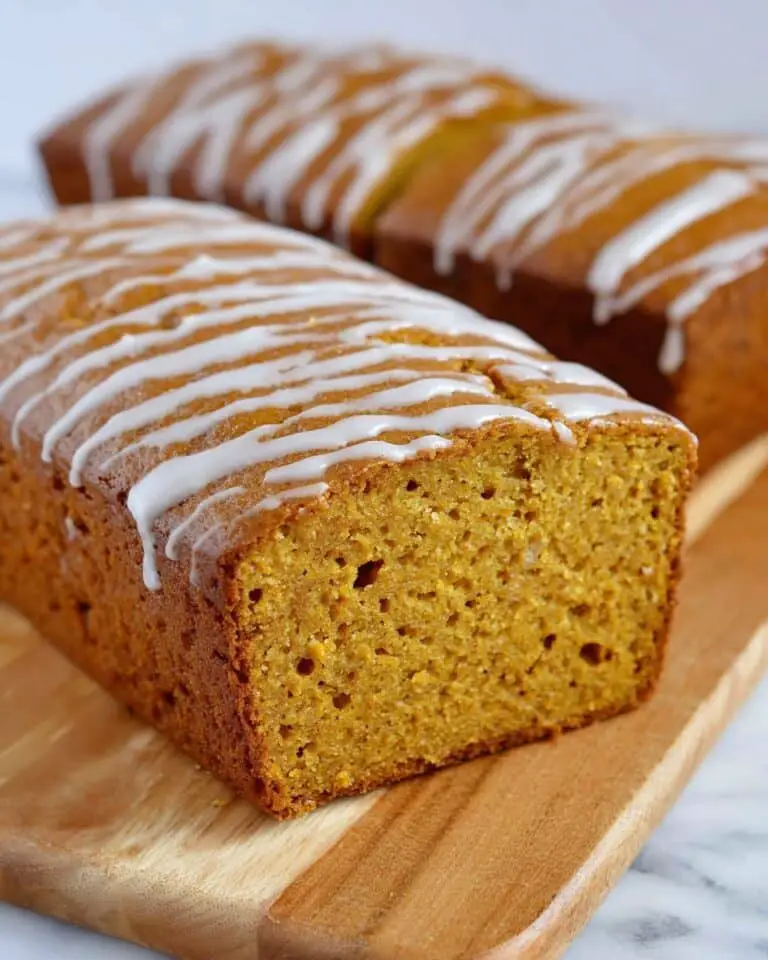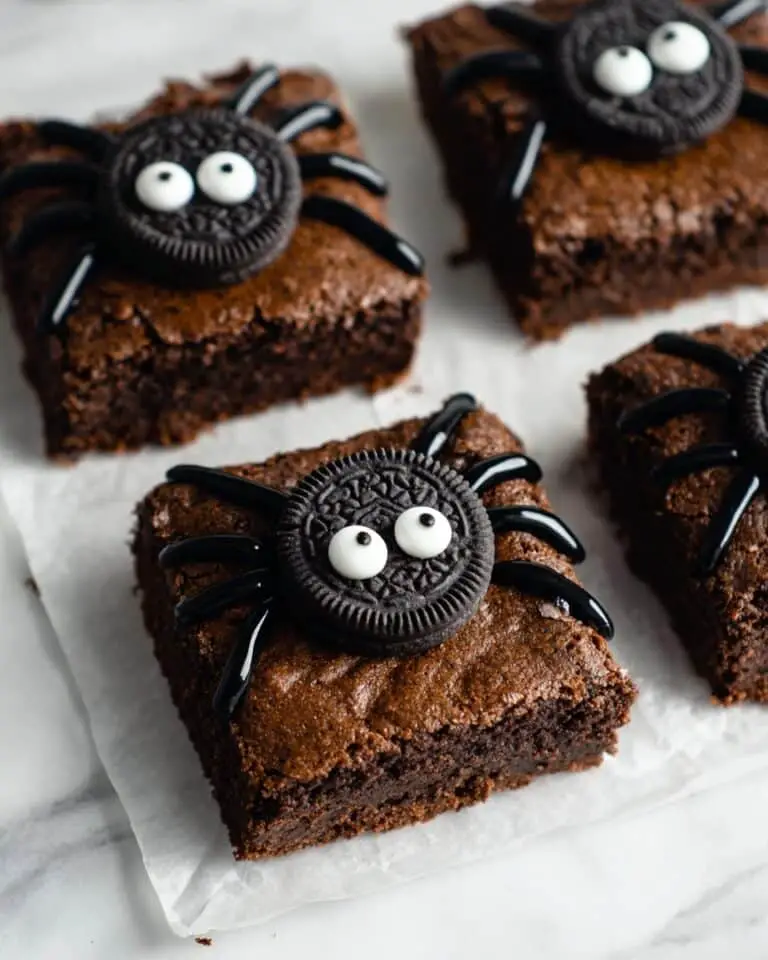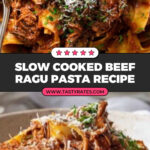If you’re looking for a comforting, soul-satisfying meal that feels like a warm hug on a plate, you’ve just found it. This Slow Cooked Beef Ragu Pasta Recipe is one of my absolute favorites to make when I want dinner that’s rich, flavorful, and downright irresistible. Trust me, this isn’t just any pasta sauce — it’s tender shredded beef swimming in a luscious, slow-simmered tomato ragu that gets better the longer it cooks. Stick with me, and I’ll share all my tips so your version comes out perfect every time.
Why You’ll Love This Recipe
- Unbeatable Flavor: Slow cooking lets all the ingredients meld into an incredibly deep, rich ragu that’s bursting with savory goodness.
- Perfectly Tender Beef: The chuck beef shreds effortlessly after hours of gentle simmering, making every bite melt in your mouth.
- Make-Ahead Friendly: This ragu tastes even better the next day and freezes wonderfully, so you can enjoy it anytime without fuss.
- Versatile & Cozy: Pair it with your favorite pasta or veggies—it’s a perfect dish for casual family dinners or special occasions.
Ingredients You’ll Need
This recipe balances simple, fresh ingredients that work in harmony during that slow cook. Each one brings something essential, so don’t skimp — and keep an eye out for good quality beef and canned tomatoes to make your ragu shine.

- Chuck Beef: I love chuck for its perfect balance of fat and connective tissue which breaks down into tender, flavorful shreds.
- Salt & Black Pepper: Simple seasonings that bring out the beef’s natural flavor and round out the sauce.
- Olive Oil: Use good quality for searing and sautéing—it adds a subtle fruity depth.
- Garlic: Minced fresh garlic adds just the right pungent kick.
- Onion: Diced onion builds the savory base alongside garlic.
- Carrots & Celery: These diced veggies contribute sweetness and texture to the ragu. I always dice them fine so they dissolve into the sauce.
- Crushed Canned Tomatoes: This forms the rich tomato base; choose a high-quality brand with no added sugar.
- Tomato Paste: Packs in concentrated tomato flavor and helps thicken the sauce.
- Beef Bouillon Cubes: Crumbled in for an umami boost that makes the sauce taste extra meaty.
- Red Wine: A full-bodied choice like Merlot or Cabernet Sauvignon adds gorgeous depth and complexity. If you don’t drink, use beef broth instead.
- Water: Balances out the liquid so the beef has room to cook slowly without drying.
- Dried Thyme & Bay Leaves: Aromatic herbs that subtly elevate the flavor without overpowering.
- Dried Pappardelle or Pasta of Choice: Wide ribbons like pappardelle cling beautifully to the chunky ragu sauce.
- Parmesan Cheese: Freshly grated, it adds salty, nutty finishing goodness. Parmigiano-Reggiano works wonders!
- Fresh Parsley (Optional): I like sprinkling a bit on top for a fresh, green pop of flavor and color.
Variations
I’ve had a lot of fun tweaking this Slow Cooked Beef Ragu Pasta Recipe over time. Feel free to make it your own — cooking should be joyful, right? Here are some ways I like to mix it up depending on my mood or pantry staples.
- Using a Slow Cooker: I sometimes sear the beef and develop the soffrito on the stovetop, then transfer everything to my slow cooker for an easy hands-off afternoon. It turns out just as tender and delicious.
- Swapping Pasta Types: Pappardelle is classic, but wide egg noodles or even rigatoni work beautifully if you want a textural change.
- Mild Heat: Adding a pinch of chili flakes when sautéing the garlic and onion gives the ragu a little kick without overwhelming the flavors.
- Vegetarian Version: For friends who don’t eat meat, I’ve made a chunky mushroom and lentil ragu with the same slow cooked technique—it’s surprisingly rich and hearty.
How to Make Slow Cooked Beef Ragu Pasta Recipe
Step 1: Sear That Beef to Lock in Flavor
Start by patting your beef pieces dry – this is a little trick I learned that helps you get a really nice crust. Season them with salt and pepper, then heat 1 tablespoon of olive oil in a heavy-based pot over high heat. Add your beef and sear aggressively, turning the pieces so each side gets browned — you want a rich, dark crust, about 3-5 minutes total. This step is non-negotiable because it forms the flavor foundation for the entire sauce. Once done, remove the beef and set it aside.
Step 2: Build Your Flavor Base with Sofrito
Lower your heat to medium-low and add the remaining 2 tablespoons of olive oil. Toss in the minced garlic and diced onion, sautéing for a couple of minutes until fragrant. Then add the diced carrots and celery, cooking slowly for about 5 minutes — this builds a natural sweetness and depth in your ragu that you really don’t want to rush.
Step 3: Add Liquids and Herbs, Then Simmer Low and Slow
Pour in the crushed canned tomatoes, tomato paste, crumbled beef bouillon cubes, red wine, and water. Toss in the thyme and bay leaves, and bring the mixture back to a gentle simmer. Return the seared beef and any juices from the plate to the pot. The trick here is to keep the simmer as low as possible — a very gentle bubble keeps the meat tender without toughening it. Cover the pot and let it cook for around 2 hours, or until the beef is tender enough to shred. I like to check in now and then to make sure it’s just bubbling and not boiling furiously.
Step 4: Shred and Reduce the Sauce to Perfection
Once the beef is so tender it practically falls apart, remove it from the pot and shred it with two forks — this is one of my favorite parts because it smells so incredible. Return the shredded beef to the ragu and simmer uncovered for another 30 minutes or so, allowing the sauce to thicken and intensify. This final reduction step lets the flavors concentrate beautifully and softens the beef even more. Give it a taste and add salt, pepper, or half a teaspoon of sugar if it’s a bit too tangy for your liking.
Pro Tips for Making Slow Cooked Beef Ragu Pasta Recipe
- Dry the Beef Thoroughly: Patting the beef dry before searing helps you get that beautiful caramelization that makes the sauce richer.
- Keep Simmering Low: I’ve learned the hard way that a hard boil toughens the meat, so maintaining a gentle simmer is key to tender results.
- Don’t Skimp on Searing: Those browned bits stuck to the pot lift the sauce’s flavor when you deglaze with wine—trust me, it’s worth the extra few minutes.
- Taste Before Serving: Acid levels in canned tomatoes vary, so adding a pinch of sugar if it tastes too tangy balances the flavors perfectly.
How to Serve Slow Cooked Beef Ragu Pasta Recipe

Garnishes
I always top this ragu pasta with a generous sprinkle of freshly grated Parmesan or Parmigiano-Reggiano cheese — it gives the dish that classic salty, umami punch. A scattering of finely chopped fresh parsley adds a lovely burst of color and freshness that brightens up each bite.
Side Dishes
My go-to pairing is a crisp green salad with a simple vinaigrette to cut through the richness of the ragu. Sometimes I also serve garlic bread on the side — perfect for mopping up any leftover sauce!
Creative Ways to Present
For special dinners, I like serving the pasta in shallow bowls, topped with the ragu and a sprig of fresh thyme or a drizzle of high-quality extra virgin olive oil. It instantly elevates the rustic look and makes guests feel like they’re at a cozy Italian trattoria.
Make Ahead and Storage
Storing Leftovers
I usually stash leftovers in airtight containers and keep them in the fridge for up to three days. The ragu thickens beautifully overnight, and the flavors deepen, so leftovers taste even better the next day.
Freezing
This recipe freezes like a dream! I portion it out into freezer-safe containers or bags and it keeps well for a few months. Just be sure to cool it completely before freezing to preserve the best texture and flavor.
Reheating
Reheat slowly on the stovetop over low heat, adding a splash of water or beef broth if it seems too thick. This helps maintain that silky consistency and keeps the beef tender.
FAQs
-
Can I use a different cut of beef for this recipe?
Absolutely! Chuck beef is ideal due to its marbling and connective tissue that breaks down nicely when slow cooked, but other slow-cooking cuts like brisket or short ribs work well too. Just make sure to adjust cooking times accordingly.
-
Can I make this Slow Cooked Beef Ragu Pasta Recipe in a slow cooker or pressure cooker?
Yes, you can adapt it for both. For a slow cooker, sear the beef and prepare the soffrito on the stove first, then transfer everything to the slow cooker and cook on low for 6-8 hours. For a pressure cooker, reduce cooking time to about 45-60 minutes under high pressure.
-
What pasta pairs best with beef ragu?
Wide, flat noodles like pappardelle are my personal favorite because they hold the chunky sauce beautifully. However, rigatoni, tagliatelle, or even polenta work wonderfully depending on your preference.
-
How do I make the sauce less acidic?
A small pinch of sugar (about ½ teaspoon) added towards the end of cooking balances out acidity from the tomatoes without making the sauce taste sweet.
-
Can I make this recipe ahead of time?
Definitely! In fact, this Slow Cooked Beef Ragu Pasta Recipe tastes even better the next day, as the flavors have more time to deepen. Just keep it refrigerated and reheat gently before serving.
Final Thoughts
This Slow Cooked Beef Ragu Pasta Recipe is like a warm Italian embrace in every bite — comfort food at its absolute finest. I still remember the first time I made it; the kitchen smelled heavenly, and my family couldn’t stop digging in. It’s a recipe that’s worth the wait and perfect for days when you want to impress without stress. Give it a try, and I’m sure it’ll become one of those dishes you crave again and again.
Print
Slow Cooked Beef Ragu Pasta Recipe
- Prep Time: 20 minutes
- Cook Time: 2 hours 30 minutes
- Total Time: 2 hours 50 minutes
- Yield: 5 to 6 servings
- Category: Main Course
- Method: Slow Cooking
- Cuisine: Italian
Description
This Slow Cooked Shredded Beef Ragu Pasta is a hearty and flavorful Italian dish featuring tender slow-cooked chuck beef simmered in a rich tomato and red wine sauce, perfect for serving over pappardelle or your favorite pasta. The long, gentle cooking process develops deep, satisfying flavors, making it an ideal meal for family dinners or special occasions.
Ingredients
Beef and Seasoning
- 1.2kg / 2.5 lb chuck beef (or other slow cooking beef cut, cut into 4 equal pieces)
- 1 tbsp salt
- Black pepper, to taste
- 3 tbsp olive oil (separated)
Vegetables and Aromatics
- 3 cloves garlic, minced
- 1 onion, diced
- 1 cup carrots, diced
- 1 cup celery, diced
Sauce Ingredients
- 800g / 28oz crushed canned tomatoes
- 3 tbsp tomato paste
- 2 beef bouillon cubes, crumbled
- 1 cup / 250ml red wine (full bodied – like Merlot or Cabernet Sauvignon) or substitute with beef broth/stock
- 1 1/2 cups / 375 ml water
- 3/4 tsp dried thyme or 3 sprigs fresh thyme
- 3 dried bay leaves
Pasta and Garnish
- 1 lb / 500g dried pappardelle or pasta of choice
- Freshly grated Parmesan cheese or Parmigiano Reggiano
- Fresh parsley, finely chopped (optional)
Instructions
- Prepare the Beef: Pat the beef dry with paper towels, then season all sides generously with salt and black pepper to enhance flavor and promote browning.
- Sear the Beef: Heat 1 tablespoon of olive oil in a heavy-based pot over high heat. Add the beef pieces and sear them aggressively on all sides until they develop a deep brown crust, approximately 3 to 5 minutes total. Remove the beef to a plate once seared.
- Sauté Aromatics: Reduce the heat to medium-low, add the remaining 2 tablespoons of olive oil to the pot. Add minced garlic and diced onion, sauté for 2 minutes until fragrant. Then add diced carrots and celery and cook gently for 5 minutes, allowing the vegetables to soften and flavors to develop.
- Add Sauce Ingredients: Stir in crushed tomatoes, tomato paste, crumbled beef bouillon cubes, red wine (or beef stock), water, dried thyme, and bay leaves. Return the seared beef along with any juices collected on the plate to the pot. Increase heat to bring to a simmer, then reduce to very low heat to maintain a gentle bubbling.
- Slow Cook the Beef: Cover the pot and cook on low heat for about 2 hours, or until the beef is tender enough to shred easily with forks. This slow cooking breaks down the meat fibers and infuses the sauce with rich beef flavor.
- Shred the Beef: Remove the beef pieces from the pot and use two forks to coarsely shred the meat. Return the shredded beef to the pot, stir well, and simmer uncovered for 30 minutes to reduce and thicken the sauce slightly; this also allows the beef to soften further.
- Final Seasoning: Taste the ragu sauce and adjust seasoning with salt and pepper as needed. If the sauce tastes too acidic, add 1/2 teaspoon of sugar to balance the flavors. Replace the lid to keep warm until ready to serve. Note: The flavors improve if allowed to rest overnight and it freezes well for future meals.
- Cook Pasta: Prepare the pappardelle or pasta of choice according to package instructions until al dente. Drain well.
- Serve: Toss the pasta with the shredded beef ragu and garnish with freshly grated Parmesan cheese and optional chopped parsley for a fresh finish.
Notes
- This recipe highlights the essence of Italian cooking with simple ingredients and long, slow simmering for depth of flavor.
- The recipe yields sauce sufficient to serve 5 to 6 people generously.
- Beef bouillon cubes add concentrated beef flavor; substitute with beef broth if preferred.
- You can use alternative slow-cooking beef cuts such as brisket or short ribs if chuck is unavailable.
- For a slow cooker adaptation, sear beef as directed, then transfer all ingredients to the slow cooker and cook on low for 6-8 hours until tender.
- To use a pressure cooker, cook on high pressure for about 60 minutes followed by natural release, then proceed with shredding.
- The sauce tastes even better when refrigerated overnight, allowing flavors to meld, and it freezes well for up to 3 months.
Nutrition
- Serving Size: 1 serving
- Calories: 678 kcal
- Sugar: 8 g
- Sodium: 1451 mg
- Fat: 26 g
- Saturated Fat: 9 g
- Unsaturated Fat: 17 g
- Trans Fat: 0 g
- Carbohydrates: 69 g
- Fiber: 5 g
- Protein: 42 g
- Cholesterol: 170 mg


